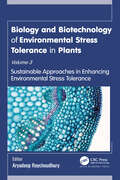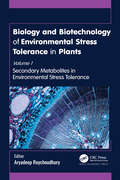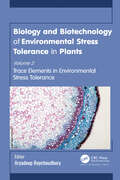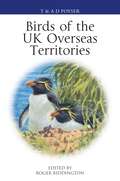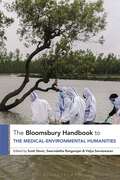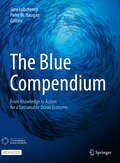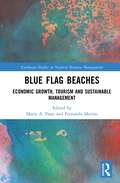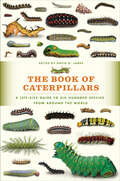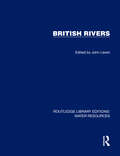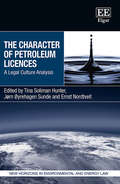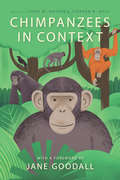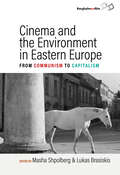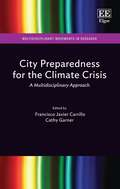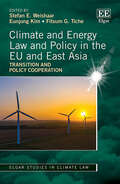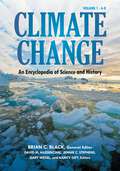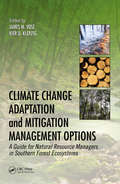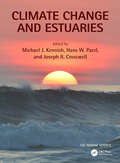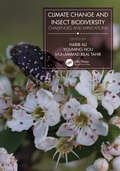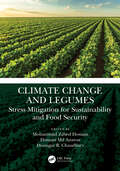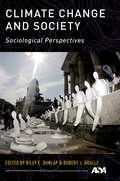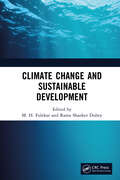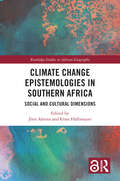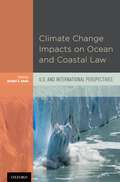- Table View
- List View
Biology and Biotechnology of Environmental Stress Tolerance in Plants: Volume 3: Sustainable Approaches for Enhancing Environmental Stress Tolerance
Abiotic stresses such as drought, high salt, cold, heat, UV radiation, heavy metal pollution, etc., are increasingly responsible for restricting plant growth and agricultural production and are becoming more alarming due to threats from global climate change. To combat these threats, this new 3-volume set provides a comprehensive understanding of the mechanisms that mediate biosynthesis, accumulation, and degradation of plant metabolites to improve crop production and enhance abiotic stress tolerance in plants. Volume 1: Secondary Metabolites in Environmental Stress Tolerance focuses exclusively on the diverse secondary metabolites that play a major role in the adaptation of plants to the environment and in overcoming stress conditions as well as their implications for enhancing tolerance mechanisms. The book presents information on the protective role rendered by a wide array of antioxidative secondary metabolites and their regulation during diverse environmental stress. Volume 2: Trace Elements in Environmental Stress Tolerance throws light on the different inorganic trace elements, including metal nanoparticles, that help to deal with environmental stresses. While these elements at high level create considerable phytotoxicity and halt metabolic and enzymatic activity, they also promote growth and development in limited quantity, so that they have significant potential in revamping plant morphology and physiology under stressed conditions. Hence, optimum concentration management of these elements can help to mitigate world hunger and contribute toward sustainable agriculture and food security under challenging environments. Volume 3: Sustainable Approaches for Enhancing Environmental Stress Tolerance focuses on the agronomic and biochemical approaches as well as biotechnological and high-throughput technologies, including the prospects of genetic engineering, epigenetics and the latest CRISPR/Cas technology, in generating stress-tolerant plants. The volume provides a clear roadmap for the implementation of techniques for improving abiotic stress tolerance in plants for better sustenance.
Biology and Biotechnology of Environmental Stress Tolerance in Plants: Volume 1: Secondary Metabolites in Environmental Stress Tolerance
Abiotic stresses such as drought, high salt, cold, heat, UV radiation, heavy metal pollution, etc., are increasingly responsible for restricting plant growth and agricultural production and are becoming more alarming due to threats from global climate change. To combat these threats, this new 3-volume set provides a comprehensive understanding of the mechanisms that mediate biosynthesis, accumulation, and degradation of plant metabolites to improve crop production and enhance abiotic stress tolerance in plants. Volume 1: Secondary Metabolites in Environmental Stress Tolerance focuses exclusively on the diverse secondary metabolites that play a major role in the adaptation of plants to the environment and in overcoming stress conditions as well as their implications for enhancing tolerance mechanisms. The book presents available information on the protective roles rendered by a wide array of antioxidative secondary metabolites and their regulation during diverse environmental stress. Volume 2: Trace Elements in Environmental Stress Tolerance throws light on the different inorganic trace elements, including metal nanoparticles, that help to deal with environmental stresses. While these elements at high level create considerable phytotoxicity and halt metabolic and enzymatic activity, they also promote growth and development in limited quantity, so that they have significant potential in revamping plant morphology and physiology under stressed conditions. Hence, optimum concentration management of these elements can help to mitigate world hunger and contribute toward sustainable agriculture and food security under challenging environments. Volume 3: Sustainable Approaches for Enhancing Environmental Stress Tolerance focuses on the agronomic and biochemical approaches as well as biotechnological and high-throughput technologies, including the prospects of genetic engineering, epigenetics and the latest CRISPR/Cas technology, in generating stress-tolerant plants. The volume provides a clear roadmap for the implementation of techniques for improving abiotic stress tolerance in plants for better sustenance.
Biology and Biotechnology of Environmental Stress Tolerance in Plants: Volume 2: Trace Elements in Environmental Stress Tolerance
Abiotic stresses such as drought, high salt, cold, heat, UV radiation, heavy metal pollution, etc., are increasingly responsible for restricting plant growth and agricultural production and are becoming more alarming due to threats from global climate change. To combat these threats, this new 3-volume set provides a comprehensive understanding of the mechanisms that mediate biosynthesis, accumulation, and degradation of plant metabolites to improve crop production and enhance abiotic stress tolerance in plants. Volume 1: Secondary Metabolites in Environmental Stress Tolerance focuses exclusively on the diverse secondary metabolites that play a major role in the adaptation of plants to the environment and in overcoming stress conditions as well as their implications in enhancing tolerance mechanisms. The book presents information on the protective roles rendered by a wide array of antioxidative secondary metabolites and their regulation during diverse environmental stress. Volume 2: Trace Elements in Environmental Stress Tolerance throws light on the different inorganic trace elements, including metal nanoparticles, that help to deal with various environmental stresses. While these elements at high level create considerable phytotoxicity and halt metabolic and enzymatic activity, they also promote growth and development in limited quantity, so that they have significant potential in revamping plant morphology and physiology under stressed conditions. Hence, optimum concentration management of these elements can help to mitigate world hunger and contribute toward sustainable agriculture and food security under challenging environments. Volume 3: Sustainable Approaches for Enhancing Environmental Stress Tolerance focuses on agronomic and biochemical approaches as well as biotechnological and high-throughput technologies, including the prospects of genetic engineering, epigenetics and the latest CRISPR/Cas technology in generating stress-tolerant plants. The volume provides a clear roadmap for the implementation of techniques for improving abiotic stress tolerance in plants for better sustenance.
Birds of the UK Overseas Territories
The UK Overseas Territories (UKOTs) are scattered across the globe. Most are small islands or island complexes, occurring from the Caribbean to the furthest reaches of the South Atlantic, via the Indian and Pacific Oceans. In terms of global biodiversity, these territories are remarkably significant. Among landscapes that range from coral atolls, through mangroves and dry forests to the ice sheets of Antarctica, the UKOTs support no fewer than 45 species of birds currently considered to be globally threatened. They are also home to a third of all the world's breeding albatrosses, and nine of the world's 17 species of penguin. In a rapidly changing world, the UKOTs symbolise global crises in climate and biodiversity. Threats faced by their wildlife range from mortality of seabirds at sea through industrial fisheries, and on land as a result of introduced ground predators, to the utter devastation of hurricanes in the Caribbean, which provide a stark reminder of our changing climate. The human impact on the wildlife of our planet has been increasing for centuries, but the next few decades promise to be critical. This book explores the birds and other wildlife of each of the 14 UKOTs, with a particular focus on environmental threats and conservation priorities. Written by authors with a deep connection to the sites, this book represents an important stocktake of the biological richness of these special places in the early 21st century.
The Bloomsbury Handbook to the Medical-Environmental Humanities (Bloomsbury Handbooks)
Bringing together two parallel and occasionally intersecting disciplines - the environmental and medical humanities - this field-defining handbook reveals our ecological predicament to be a simultaneous threat to human health. The book: · Represents the first collection to bring the environmental humanities and medical humanities into conversation in a systematic way· Features contributions from a wide range of interdisciplinary perspectives including literary studies, environmental ethics and philosophy, cultural history and sociology · Adopts a truly global approach, examining contexts including, but not limited to, North America, the UK, Africa, Latin America, South Asia, Turkey and East Asia · Touches on issues and approaches such as narrative medicine, ecoprecarity, toxicity, mental health, and contaminated environments. Showcasing and surveying a rich spectrum of issues and methodologies, this book looks not only at where research currently is at the intersection of these two important fields, but also at where it is going.
The Blue Compendium: From Knowledge to Action for a Sustainable Ocean Economy
Home to over 80 percent of all life on Earth, the ocean is the world’s largest carbon sink and a key source of food and economic security for billions of people. The relevance of the ocean for humanity's future is undisputed. However, the ocean’s great potential to drive economic growth and equitable job creation, sustain healthy ecosystems, and mitigate climate change is not yet fully recognised. Lack of awareness of this potential as well as management and governance challenges pose impediments. Until these impediments are removed, ocean ecosystems will continue to be degraded and opportunities for people lost. A transition and a clear path to a thriving and vibrant relationship between humans and the ocean are urgently needed. This open access collection of papers and reports identifies a path that is inspired by science, energised by engaged people, and emboldened by visionary leaders. These assessments of knowledge are commissioned by the High Level Panel for a Sustainable Ocean Economy (Ocean Panel), which was established in September 2018 as a unique initiative led by heads of state and government from around the world, to showcase the latest leading-edge science, knowledge and state-of-the-art thinking on key ocean issues. Altogether, The Blue Compendium offers innovative ocean solutions in technology, policy, governance, and finance realms, that could help accelerate a transition to a more sustainable and prosperous relationship with the ocean. The comprehensive assessments have already informed policy making at the highest levels of government and motivated an impressive array of responsive and ambitious action across a growing network of leaders in business, finance and civil society.
Blue Flag Beaches: Economic Growth, Tourism and Sustainable Management (Earthscan Studies in Natural Resource Management)
This book presents a comprehensive study of the role that the Blue Flag beach program has played around the world, considering economic, social and environmental perspectives. Since its creation in the 1980s, The Blue Flag program awards the management of beaches and marinas based on sustainability, services and quality of their management. To date there are currently close to five thousand awards around the world. Forty years on from the program's creation, this book provides a thorough evaluation of the program, to understand how it has evolved over time, the successes it has enjoyed and the challenges it has overcome, and may face in the future. As an international program, this book reflects the global nature of this program and actively discusses, examines and assesses the different realities and challenges faced by different countries around the world, drawing on case studies from across Europe, North America, Latin America, Africa and Asia. It examines the impact of the award on economic growth, from local to national, environmental protection and education, the development of sustainable tourism, and the sustainable management of beaches. The volume also contributes to emerging debates surrounding the certification of natural resources, where the Blue Flag program has been a pioneer in this field. This book will be of great interest to students and scholars of sustainable tourism, environmental economics, coastal and beach management, environmental conservation and sustainable development.
The Book of Caterpillars: A Life-Size Guide to Six Hundred Species from around the World
The weird and wonderful world of insects boasts some of the strangest creatures found in nature, and caterpillars are perhaps the most bizarre of all. While most of us picture caterpillars as cute fuzzballs munching on leaves, there is much more to them than we imagine. A caterpillar’s survival hinges on finding enough food and defending itself from the array of natural enemies lined up to pounce and consume. And the astounding adaptations and strategies they have developed to maximize their chances of becoming a butterfly or moth are only just beginning to be understood, from the Spicebush Swallowtail caterpillar that resembles a small snake to the Eastern Carpenter Bee Hawkmoth caterpillar that attempts to dissuade potential predators by looking like a diseased leaf. The Book of Caterpillars unveils the mysteries of six hundred species from around the world, introducing readers to the complexity and beauty of these underappreciated insects. With the advent of high-quality digital macrophotography, the world of caterpillars is finally opening up. The book presents a wealth of stunning imagery that showcases the astonishing diversity of caterpillar design, structure, coloration, and patterning. Each entry also features a two-tone engraving of the adult specimen, emphasizing the wing patterns and shades, as well as a population distribution map and table of essential information that includes their habitat, typical host plants, and conservation status. Throughout the book are fascinating facts that will enthrall expert entomologists and curious collectors alike. A visually rich and scientifically accurate guide to six hundred of the world’s most peculiar caterpillars, this volume presents readers with a rare, detailed look at these intriguing forms of insect life.
British Rivers (Routledge Library Editions: Water Resources)
Originally published in 1981, this book describes and interprets the physical nature of British rivers and is authored by leading authors from universities, the Institute of Hydrology and a water Authority. The contents include data on river regimes and catchment characteristics, information on water quality in both polluted and unpolluted rivers, a full discussion of river channels and their erosion and sediment characteristics, and a consideration of river management problems in the distinctive British context. Where possible, nationwide information is presented in map form and many of the maps presented a national picture for the first time. The book will be of interest to students and scientists in a wide range of disciplines: geography, geology, environmental science, hydrology and engineering. Those professionally engaged in environmental management and the water industry should also find it useful. In summary, all who are concerned with rivers – as agents of landscape change, sedimenting phenomena, environmental resources or flood hazards will find this book as relevant now as when it was first published.
Butterflies: Ecology and Evolution Taking Flight
In Butterflies: Ecology and Evolution Taking Flight, the world's leading experts synthesize current knowledge of butterflies to show how the study of these fascinating creatures as model systems can lead to deeper understanding of ecological and evolutionary patterns and processes in general. The twenty-six chapters are organized into broad functional areas, covering the uses of butterflies in the study of behavior, ecology, genetics and evolution, systematics, and conservation biology. Especially in the context of the current biodiversity crisis, this book shows how results found with butterflies can help us understand large, rapid changes in the world we share with them—for example, geographic distributions of some butterflies have begun to shift in response to global warming, giving early evidence of climate change that scientists, politicians, and citizens alike should heed. The first international synthesis of butterfly biology in two decades, Butterflies: Ecology and Evolution Taking Flight offers students, scientists, and amateur naturalists a concise overview of the latest developments in the field. Furthermore, it articulates an exciting new perspective of the whole group of approximately 15,000 species of butterflies as a comprehensive model system for all the sciences concerned with biodiversity and its preservation. Contributors: Carol L. Boggs, Paul M. Brakefield, Adriana D. Briscoe, Dana L. Campbell, Elizabeth E. Crone, Mark Deering, Henri Descimon, Erika I. Deinert, Paul R. Ehrlich, John P. Fay, Richard ffrench-Constant, Sherri Fownes, Lawrence E. Gilbert, André Gilles, Ilkka Hanski, Jane K. Hill, Brian Huntley, Niklas Janz, Greg Kareofelas, Nusha Keyghobadi, P. Bernhard Koch, Claire Kremen, David C. Lees, Jean-François Martin, Antónia Monteiro, Paulo César Motta, Camille Parmesan, William D. Patterson, Naomi E. Pierce, Robert A. Raguso, Charles Lee Remington, Jens Roland, Ronald L. Rutowski, Cheryl B. Schultz, J. Mark Scriber, Arthur M. Shapiro, Michael C. Singer, Felix Sperling, Curtis Strobeck, Aram Stump, Chris D. Thomas, Richard VanBuskirk, Hans Van Dyck, Richard I. Vane-Wright, Ward B. Watt, Christer Wiklund, and Mark A. Willis
Capacity Mechanisms in the EU Energy Markets: Law, Policy, and Economics
Capacity remuneration mechanisms (or simply capacity mechanisms) have become a fact of life in member states' energy markets and are one of the hottest topics in the wider European regulatory debate. Concerned about the security of electricity supply, national governments are implementing subsidy schemes to encourage investment in conventional power generation capacity, alongside already heavily subsidized renewable energy sources. With the increasingly connected European electricity markets, the introduction of a capacity mechanism in one country not only tends to distort its national market but may also have unforeseeable consequences for neighbouring electricity markets. As these mechanisms are adopted by member states with limited supra-national coordination as well as consideration for the cross-border impact, they tend to cause serious market distortions and put the future of the European internal electricity market at risk. This second edition will take stock of how capacity mechanisms have actually worked so far and consider the consequences they have for the European internal electricity market. It will include a detailed overview of national capacity mechanisms, their implications for the EU internal market, and will outline the nature of market failures which are likely to occur in the European electricity markets. This edition is intended to serve as a point of reference for regulators and policy-makers on how to design optimal capacity mechanisms in Europe. It will be an invaluable resource for anyone interested in energy market design, regulation, and competition issues.
The Character of Petroleum Licences: A Legal Culture Analysis (New Horizons in Environmental and Energy Law series)
This innovative book explores the legal character of petroleum licences, a key vehicle governing the relationship between oil companies and their host states. Examining the issue through the lens of legal culture, it illustrates why some jurisdictions exert strong state control and others only minimal. Critically investigating the nature of a petroleum licence, the book analyses whether it is a mere administrative right, a contract or something more akin to property rights. Chapters examine recent developments, such as the UK’s strategy of maximizing economic recovery and the opposition to drilling for oil in Norway and Australia. Outside of Western petroleum jurisdictions, the book also explores several long-established jurisdictions including Russia and Mexico, as well as emerging jurisdictions, such as China and Uganda. Taking a contextual and system-oriented approach, it reveals the preconditions of the petroleum licence regime and offers a critical insight into the reasons behind alterations to the terms of the licences. Encompassing a wide variety of legal cultures and experiences, this thought-provoking book will prove to be a valuable resource for academics and students of energy law, particularly those with an interest in state regulation. It will also provide useful insights for industry-based practitioners.
Chimpanzees in Context: A Comparative Perspective on Chimpanzee Behavior, Cognition, Conservation, and Welfare
The study of the chimpanzee, one of the human species’ closest relatives, has led scientists to exciting discoveries about evolution, behavior, and cognition over the past half century. In this book, rising and veteran scholars take a fascinating comparative approach to the culture, behavior, and cognition of both wild and captive chimpanzees. By seeking new perspectives in how the chimpanzee compares to other species, the scientists featured offer a richer understanding of the ways in which chimpanzees’ unique experiences shape their behavior. They also demonstrate how different methodologies provide different insights, how various cultural experiences influence our perspectives of chimpanzees, and how different ecologies in which chimpanzees live affect how they express themselves. After a foreword by Jane Goodall, the book features sections that examine chimpanzee life histories and developmental milestones, behavior, methods of study, animal communication, cooperation, communication, and tool use. The book ends with chapters that consider how we can apply contemporary knowledge of chimpanzees to enhance their care and conservation. Collectively, these chapters remind us of the importance of considering the social, ecological, and cognitive context of chimpanzee behavior, and how these contexts shape our comprehension of chimpanzees. Only by leveraging these powerful perspectives do we stand a chance at improving how we understand, care for, and protect this species.
Cinema and the Environment in Eastern Europe: From Communism to Capitalism
The annexation of Eastern Europe to the Soviet sphere after World War II dramatically reshaped popular understandings of the natural environment. With an eco-critical approach, Cinema and the Environment in Eastern Europe breaks new ground in documenting how filmmakers increasingly saw cinema as a tool to critique the social and environmental damage of large-scale projects from socialist regimes and newly forming capitalist presences. New and established scholars with backgrounds across Europe, the United States, and Australia come together to reflect on how the cultural sphere has, and can still, play a role in redefining our relationship to nature.
City Preparedness for the Climate Crisis: A Multidisciplinary Approach (Multidisciplinary Movements in Research)
Exploring the ways that contemporary urban life takes the Holocene for granted, this multidisciplinary book warns that anthropogenic environmental impacts are on course to challenge the viability of most human settlements. It highlights how, despite increased warnings, most cities appear to be in denial of the potential impending catastrophes and remain ill-prepared to handle major disruptions. Chapters offer a critical appraisal of the end of an urban epoch: the Holocene city. Moving from more general aspects of urban vulnerability in the face of the Anthropocene, the book then looks at more specific issues and cases illustrating alternative adaptation pathways. It further analyses existing approaches, movements and networks for urban preparedness for the climate crisis, offering visualisations of the ways these can be improved, conceiving alternative futures and reinventing the city. A timely resource for this emerging topic, the book will be beneficial to urban studies, environmental science and development studies scholars. Practitioners in urban planning, design, management and evaluation will also find the critical case studies in the book particularly helpful.
Climate and Energy Law and Policy in the EU and East Asia: Transition and Policy Cooperation (Elgar Studies in Climate Law)
Greenhouse gas concentrations are rapidly increasing and as a result, fundamental economic transitions are needed to limit global warming. This essential book examines the climate and energy policies of selected jurisdictions in Europe and East Asia that have vowed to become carbon neutral.Climate and Energy Law and Policy in the EU and East Asia provides important analyses of the respective laws and policies of the European Union, China and South Korea, and also touches upon Japan. Accounting for 43% of global CO2 emissions, these jurisdictions are critical for success. While nations share a common goal, the way policy priorities are set, and the ways in which the climate crisis is managed, differ tremendously. Chapters examine different law and policy approaches, constraints and resulting implications for cooperation, thereby contributing to the climate and energy transition discussions and offering much-needed policy insights.This timely book will be of great interest to researchers, students and scholars focusing on climate and energy law and policy. It will additionally be beneficial for policymakers and government officials seeking to understand changes in energy policy.
Climate Change [4 volumes]: An Encyclopedia of Science and History [4 volumes]
This book provides a holistic consideration of climate change that goes beyond pure science, fleshing out the discussion by considering cultural, historical, and policy-driven aspects of this important issue.Climate change is a controversial topic that promises to reframe rudimentary ideas about our world and how we will live in it. The articles in Climate Change: An Encyclopedia of Science and History are designed to inform readers' decision making through the insight of scholars from around the world, each of whom brings a unique approach to this topic. The work goes beyond pure science to consider other important factors, weighing the cultural, historical, and policy-driven contributors to this issue. In addition, the book explores the ideas that have converged and evolved in order to clarify our current predicament. By considering climate change in this holistic fashion, this reference collection will prepare readers to consider the issue from every angle. Each article in the work is suitable for general readers, particularly students in high school and college, and is intended to inform and educate anyone about climate change, providing valuable information regarding the stages of mitigation and adaptation that are occurring all around us.
Climate Change Adaptation and Mitigation Management Options: A Guide for Natural Resource Managers in Southern Forest Ecosystems
Forest land managers face the challenges of preparing their forests for the impacts of climate change. However, climate change adds a new dimension to the task of developing and testing science-based management options to deal with the effects of stressors on forest ecosystems in the southern United States. The large spatial scale and complex inter
Climate Change and Estuaries (CRC Marine Science)
Climate change is having an increasing impact on coastal, estuarine, and marine environments worldwide. This book provides state-of-the-art coverage of climate change effects on estuarine ecosystems from local, regional, and global perspectives. With editors among the most noted international scholars in coastal ecology and estuarine science and contributors who are world-class in their fields, the chapters in this volume consist of comprehensive studies in coastal, estuarine and marine sciences, climate change, and coastal management and provide an extensive international collection of data in tabular, illustrated, and narrative formats useful for coastal scientists, planners, and managers. Comprised of three sections: (1) physical-chemical aspects; (2) biological aspects; and (3) management aspects, the book not only examines climatic and non-climatic drivers of change affecting coastal, estuarine, and marine environments but also their interactions and effects on populations of organisms, communities, habitats, and ecosystem structure and function. Pulling together today’s most salient issues and key literature advances for those concerned with coastal management, it allows the reader to see across direct and indirect interactions among disciplinary and ecosystem boundaries. Climate Change and Estuaries meets the research needs of climate scientists, estuarine and marine biologists, marine chemists, marine geologists, hydrologists, and coastal engineers, while students, professors, administrators, and other professionals will also find it an exhaustive reference.
Climate Change and Insect Biodiversity: Challenges and Implications
This up-to-date reference book discusses the effects of climate change on the biodiversity of insect pests. The changing climate and agricultural intensification practices impact negatively on insect biodiversity. The book explains the significance of insect pests for evaluating climatic impacts on a wide range of ecological systems. It covers the effect of climate change on pollinators and household and agricultural insect pests. It explains how climate-smart agriculture can enhance productivity and food security.FEATURES Reviews the effects of climate change on plant-insect interactions Includes topics such as insect biodiversity informatics and conservation Discusses food security, pest management, and beneficial and social insects Covers topics such as precision agriculture and climate-smart agriculture Provides insights on the relation between agriculture intensification and insect biodiversity This book is meant for scientists, researchers, and students working in the fields of agriculture, entomology, ecology, plant science, environmental biology, and biotechnology.
Climate Change and Legumes: Stress Mitigation for Sustainability and Food Security
Global climate change has created unprecedented challenges for human civilization due to its widespread adverse consequences, including a reduction in crop yield and threatening food security across the globe. Among the crop plants, legumes have great potential for ameliorating global warming since they can reduce carbon emissions by lowering reliance on the application of chemical fertilizers, by increasing nitrification and carbon sequestration in soil, and by providing protein-rich diets to both humans and livestock. This book identifies the extent of climate-induced stresses on legume plants and focuses on achieving food security through sustainable agricultural practices.This book compiles recent research findings and reviews on climate-related problems, the potential of legumes in ameliorating the impacts of climate change, as well as better management of agricultural land and practices for achieving environmental sustainability and food security.This book will serve as guidelines for scientists, agricultural practitioners, and policymakers working to achieve food security and better management of climate-induced stresses in agricultural interventions. It will also be useful as a reference book for researchers and students of both graduate and postgraduate levels. Furthermore, this book will provide enhanced knowledge about the mechanisms of yield and stress tolerance of legumes as well as developing climate-smart crops and improving cropping systems for a sustainable environment and food security. Features of the book Reviews trends of global climate change and its consequences for food security across the continents Identifies the challenges and scopes of cultivating legumes in achieving food security in the context of global climate change Focuses on the improvements of legume production through conservation approaches in agricultural practices and modern techniques, including omics-based breeding, biotechnology, genetic engineering, and rhizobium technology Discusses the sustainable amelioration options for soils affected by climate-induced stresses Cites examples of applications of rhizobium technologies in reducing greenhouse gas emission Describes pathways associated with yield, resistance, and tolerance of legumes to climate-induced stresses
Climate Change and Society: Sociological Perspectives
Climate change is one of the most critical issues of the twenty-first century, presenting a major intellectual challenge to both the natural and social sciences. While there has been significant progress in natural science understanding of climate change, social science analyses have not been as fully developed. Climate Change and Society breaks new theoretical and empirical ground by presenting climate change as a thoroughly social phenomenon, embedded in behaviors, institutions, and cultural practices. This collection of essays summarizes existing approaches to understanding the social, economic, political, and cultural dimensions of climate change. From the factors that drive carbon emissions to those which influence societal responses to climate change, the volume provides a comprehensive overview of the social dimensions of climate change. An improved understanding of the complex relationship between climate change and society is essential for modifying ecologically harmful human behaviors and institutional practices, creating just and effective environmental policies, and developing a more sustainable future. Climate Change and Society provides a useful tool in efforts to integrate social science research, natural science research, and policymaking regarding climate change and sustainability. Produced by the American Sociological Association's Task Force on Sociology and Global Climate Change, this book presents a challenging shift from the standard climate change discourse, and offers a valuable resource for students, scholars, and professionals involved in climate change research and policy.
Climate Change and Sustainable Development
Climate Change and Sustainable Development covers the climatic and atmospheric changes, greenhouse gases and their impact on eco-system, biodiversity, water resources, agriculture and food security, human health, extreme weather and environment across two sections. The mitigation and adaptation strategies involving sustainable development is also illustrated including efficient technology, renewable energy, developmental activities control and so forth. Nanotechnology for sustainable development, forest protection, environment, social and economic sustainability and climate change policy planning of international bodies like UNFCC, UNDP, Kyoto protocol is also included. Features: Covers climate change fundamentals and its impact on different ecosystems and natural disasters Describes non-renewable energy aspects like fossil fuel, coal, oil, natural gas and so forth Explores sustainable development in terms of environment, social and economic aspects Includes species diversity and loss, agriculture productivity, water resources scarcity, health and environmental, rise in sea level and coastal area submergence Illustrates scientific hybridization of traditional ecological knowledge for enhancing climate change adaptation This book is aimed at graduate students and researchers in engineering and public policy, engineering management, sustainable engineering, renewable energy engineering, environmental engineering, and sustainability.
Climate Change Epistemologies in Southern Africa: Social and Cultural Dimensions (Routledge Studies in African Geography)
This book investigates the social and cultural dimensions of climate change in Southern Africa, focusing on how knowledge about climate change is conceived and conveyed. Despite contributing very little to the global production of emissions, the African continent looks set to be the hardest hit by climate change. Adopting a decolonial perspective, this book argues that knowledge and discourse about climate change has largely disregarded African epistemologies, leading to inequalities in knowledge systems. Only by considering regionally specific forms of conceptualizing, perceiving, and responding to climate change can these global problems be tackled. First exploring African epistemologies of climate change, the book then goes on to the social impacts of climate change, matters of climate justice, and finally institutional change and adaptation. Providing important insights into the social and cultural perception and communication of climate change in Africa, this book will be of interest to researchers from across the fields of African studies, sociology, anthropology, philosophy, political science, climate change, and geography.
Climate Change Impacts on Ocean and Coastal Law: U.S. and International Perspectives
Ocean and coastal law has grown rapidly in the past three decades as a specialty area within natural resources law and environmental law. The protection of oceans has received increased attention in the past decade because of sea-level rise, ocean acidification, the global overfishing crisis, widespread depletion of marine biodiversity such as marine mammals and coral reefs, and marine pollution. Paralleling the growth of ocean and coastal law, climate change regulation has emerged as a focus of international environmental diplomacy, and has gained increased attention in the wake of disturbing and abrupt climate change related impacts throughout the world that have profound implications for ocean and coastal regulation and marine resources. Climate Change Impacts on Ocean and Coastal Law effectively unites these two worlds. It raises important questions about whether and how ocean and coastal law will respond to the regulatory challenges that climate change presents to resources in the oceans and coasts of the U.S. and the world. This comprehensive work assembles the insights of global experts from academia and major NGOs (e.g., Center for International Environmental Law, Ocean Conservancy, and Environmental Law Institute) to address regulatory challenges from the perspectives of U.S. law, foreign domestic law, and international law.
